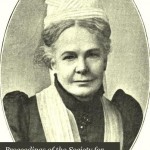In our continued subliminal messages research, we found this article. Again this is not what is considered subliminal messages today but it is interesting how this terminology has evolved.
Our Continued Subliminal Messages Research
“Mn. F. W. H. Myers then concluded his address (begun May 29th), on “Problems of Personality,” the substance of which will, it is hoped, appear in our Proceedings. The speaker reviewed the various classes of automatic and subliminal messages in their relation to the primary memory of the automatist.
In the first place, some of these messages, like the “inspirations of genius,” or the brief apparitions which showed no purposive action of their own, seemed to be assumed without any perceptible break iato the superficial chain of memory.
Secondly, in certain cases, a subsidiary or concurrent chain of memory was manifested, as, for instance, in ordinary automatic writing, where the messages written exhibited an intelligence involving memory, but not necessarily interfering with the automatist’s primary intelligence and memory, which might be occupied with other matters while the message was being written.
In the third place, the secondary chain of memory sometimes became sufficiently dominant to alternate with the primary,—as in such cases as those of Mme. B., Felida X., Ansel Bourne, ic.
In the fourth place, there were sometimes indications that a fusion of memories had occurred, or at any rate that the subliminal memory was’ wider in its scope, and represented the individuality more completely than the superliminal.
The question of the various origins of automatic messages was then once more discussed. It was concluded that, while at our present stage of knowledge it was very difficult to distinguish what the subliminal self might have itself acquired through the exercise of clairvoyant or similar powers from what it might have acquired by telepathic impact from other intelligences, yet there was reason to suppose that both these factors must be taken into account. Indeed, the very existence of the clairvoyant powers of the subliminal self indicated a realm of laws under which even direct communication from disearnate intelligences lost much of its antecedent improbability.”
And that concludes the subliminal messages research that was done at that time.
We stumbled upon a paper on Subliminal Messages in Advertising that we thought you might be interested in.
Title: Subliminal Messages in Advertising.
Authors: Olson, Miles C.
The technique of subliminal information giving has been considerably broadened in recent years so that magazine ads now employ it by carefully hiding images where they are not usually perceived with the conscious eye. In his recent book, “Subliminal Seduction: Ad Media’s Manipulation of a Not So Innocent America,” Wilson B. Key demonstrates that subliminal messages in ads are perceived and do have an impact on attitudes and actions. After conducting his own personal search to find the “hidden persuaders,” the author of this article was convinced that advertisements are full of hidden information, which is usually of a sexual nature. He suggests that it is important that English teachers become aware of this phenomenon, since it is a part of communication. Furthermore, he contends that we cannot accept or reject such information until we become conscious of it and are able to act on it in our normal, rational ways. (LL)
That is just an excerpt from Subliminal Messages in Advertising, as we are working on getting you a full copy.
During the course of my subliminal messages research , I discovered this article written in the late 1800s. Although this is not what we mean by subliminal messages today, it is interesting to see this terminology used in reference to hysteria.
THE SUBLIMINAL CONSCIOUSNESS.
By Frederic W. H. Myers.
The Mechanism Of Hysteria.
The survey of human personality on which we are now engaged ;— involving as it does the discovery and discussion of such intimations as upraise themselves in many quarters from the hidden or submerged strata of our being into the consciousness of ordinary life;—is a survey of which no single section can be complete until the whole field has been passed under review. On the other hand, fresh problems present themselves in each department as fresh phenomena are noted in other departments, and closer interrelations discerned or divined. And besides this increasingcomplexity there is an increasing marvellousness in the phenomena gradually encountered, which must needs send us back again and again in search of phenomena analogous, but less startling in character.
It is reasonable, therefore, that before we pass on from the complex and marvellous phenomena described under the head of sensory automatism to the no less surprising facts of motor automatism.— especially of automatic script and speech—we should pause and consider how far our definition of motor automatism is to extend, and what earlier or simpler phases thereof may point the way to those highly-developed telepathic motormessages with which we are mainly to be concerned.
In the first place we shall observe once more—what has often been already manifest—that the simple partition of nervous action into sensory and motor does not suffice as a logical scheme for the arrangement of subliminal messages. We are not, indeed, entitled to assume that what we call sensory or motor qualities are inherent in these messages, either as received telepathically from others, or as initiated in the depths of our own being. Such qualities may be the mere translation into terms intelligible by the supraliminal self of impressions for which we possess no specialised term ;—impressions which we should be obliged to describe vaguely as “organic “;—although, for aught we know, they may in reality be themselves specialised in categories of which we have at present no conception. This seems to be the case with many even of those subliminal messages which are ultimately clothed in the most definite sensory form. An apparition or a phantasmal voice may be the exteriorisation of a telepathic impact which has first shown itself in a mere sense of apprehension or malaise. Such an apparition is no simple optical presentation; we may call it if we please an internal vision, but its deeper initiatory processes are as yet unknown.
Still more markedly is this the case with motor automatisms. The telepathic transmission of a message directly prompting to a motor act (as of writing) has no even apparent parallel in ordinary life. For I cannot directly prompt my friend to a motor act; I can so prompt him only by first producing upon him some sensory impression. I can tell him to write; I can stir him to answering speech; but my volition cannot touch his motor centres of hand or throat except through some such indirect road. All the harder, then, is it to conceive from what form of initial impulse these motor automatisms spring; all the more are we bound to study such vague, organic, internuntial messages as we can detect in their passage from one stratum of our psychical being to another, before we deal with the full-blown motor messages, telepathic or otherwise, which are conveyed by automatic script or voice. In other words, and using my old metaphor, before we follow motor automatism above the psychological end of the conscious spectrum, we must trace its beginnings below the physiological end. We must analyse the influence of motor and quasi-motor messagesupon the organic functions before we analyse the intellectual contents of such messages, or discuss the source of such definite knowledge as they may contain.
To some extent this has been already done in previous chapters. Discussing the Mechanism of Suggestion (Chap. II.), we encountered many vaso-motor and trophic changes over tvhich, in my view, the hypnotic stratum of the Self exerts habitual control. Again, the Inspirations of Genius(Chap. III.) were seen to have their motor side, both in the plastic arts, in music, and in oratory; although the greater detiniteness of mathematical achievements led us to dwell mainly on a. form of genius whose results are conceived and expressed mainly in visual terms. Dreams, which were next touched upon, involve obscure forms of motor as well as of sensory excitation; and the very name of somnambulism points to a pitch of dream-intensity at which its motor impulses translate themselves into more or less coherent action.
On these topics, then, I must be content to refer my readers to what has already been briefly and imperfectly said. But there is one cognate topic of great importance—one repertory of subliminal messages especially of the vaguer organic types—on which I have as yet touched so meagrely that I must needs here discuss its lessons at some length before proceeding to those more specialised and intellectual motor messages of which automatic writing is the familiar type. I allude to the whole range of morbid interchanges or interactions between one section of the personality and another,—those “self-suggestive maladies,” or “diseases of the hypnotic stratum,” as I have termed them (Proceedings, Vol. VIII., p. 309), “whose differentia is an irrational self-suggestion in regions beyond the powers of the waking will;—a morbid or uncontrolled functioning of powers over the organism which effect profounder modifications than the empirical self can parallel.” For convenience’ sake we may continue to give to all these perturbations the meaningless name of “hysteria “;—trusting that the reader will divest his mind of those popular notions of hysteria which merely reflect and misinterpret some superficial symptoms of a group of maladies which are among the most formidable, and the most instructive, disturbances to which human minds and bodies are exposed.
To define hysteria in nosological terms, by cataloguing and connecting its symptoms, is well known to be an impossible task. In our ignorance of the physical genesis and interrelation of those symptoms we cannot predict from one day to another what evolution the disease will follow, or what new phenomena may occur. If we would attain to a comprehensive view, we must seek it from some psychological standpoint. And we must begin by distinguishing all ordinary diseases, taken together, from their hysterical simulations, as profoundly as we distinguish all placental mammals from the marsupial parodies which by some freak of evolution so strangely mimic placental forms.
On the one hand we have a series of definite, objective lesions, inflicted upon the organism by some external injury, or by some internal operation of microbes, malnutrition, heredity disease, or senile decay. On the other hand, and side by side with this series, we have another series of what I may term phantom lesions, depending, of course, ultimately upon some cerebral conditions—hereditary, selfdeveloped, or traumatic;—but so depending in an indirect rather than in a direct fashion, not as incapacities anatomically following on injury to definite nervous centres or tracts, but as the apparently capricious manifestations of an injury presumably affecting some unknown seat of highest co-ordination; in short, asperturbations of personality, which work themselves out through some morbid process of self-suggestion, according to laws of association cognisable by us, if at all, from the intellectual rather than from the anatomical side.
These phantom lesions, I say, are not like anatomical injuries, but like some ignorant patient’s objectified dream. Hysterical patches of anaesthesia do not correspond with any true areas of ordinary sensory innervation; they seem to follow the patient’s crude notions of where his limbs begin and end ; they are ” anaesthetic bracelets,” “anaesthetic boots.” The eye – troubles of the hysteric affect not the optical mechanism alone, but all that the ophthalmic patient would call his”eye ” ;—-all that occupies or surrounds the orbit. Nay, certain wellknown syndromes—as the so-called hysterical “astasia-abasia,” or inability to walk and stand—are, if I may so say, unblushingly intellectual in character, are the mere abolition by some profound self-suggestion of one special set of co-ordinated movements deeply rooted, first in the supraliminal, then in the subliminal life. The “rhythmic chorea,” or “danse de S. Guy,” on the other hand, so common in mediaeval Germany, is an intensification of an acquired synergy, a helpless prolongation of a set of co-ordinated movements which the patient is unable to arrest, as the boy in the fairy tale was unable to arrest the mill,whose controlling charms he had forgotten, and which is still grinding out salt at the bottom of the sea. On these points all will agree. And I may suggest that from my own special point of view hysterical “allocheiria “—the confusion or reversal of motor conceptions of left and right—is but thedegenerative counterpart of that ambidexterity which I regard as now accompanying the evolutionary process in man ; and, moreover, that hysterical attaques de sommeil are but that reversion to our primitive state of personality which is natural, which was even predictable, amid the upheavals of this psychic storm.
In 2007, to mark the 50th anniversary of James Vicary’s original experiment…
Read the rest here: http://en.wikipedia.org/wiki/Subliminal_stimuli
Another article on debunking the debunkers. What do you think?
http://www.huffingtonpost.com/alyssa-jung/super-bowl-ad-to-tackle-c_b_819107.html
Another story on subliminal messages in a Disney movie. Check it out for yourself. Why do you think they put subliminal messages in these movies?
http://blog.moviefone.com/2011/02/16/disney-subliminal-sex-images/
New research suggests negative suggestions are more useful than positive suggestions. Read more http://www.cbsnews.com/8301-503983_162-5346300-503983.html
I want to hear your options on subliminal messages. Do you believe subliminal advertising are influencing the buying public? If so how specifically are people being subliminally influenced?
A great article on what it takes in the real world to get lucky.
http://shine.yahoo.com/event/lifeslittlepleasures/how-to-get-lucky-2389062/
In this commercial by Miller Lite the implication that no one seems to notice is that the beer tastes good. Watch and listen to this commercial and notice it is unconsciously effective.



